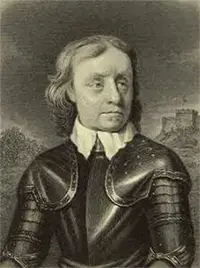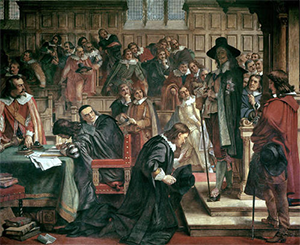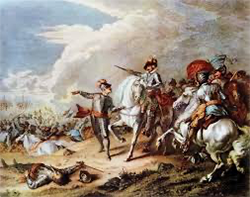Oliver Cromwell
Oliver Cromwell was a distinguished cavalry officer during the English Civil Wars and served as the effective head of the English government after the death of King Charles I. 
He was born on April 25, 1599, in Huntingdon. He attended Huntingdon Grammar School and then Sidney Sussex College at Cambridge University. He left school when his father died, in 1617, without completing a degree, in order to work the family homestead and support his mother and sisters. In 1620, he married Elizabeth Bourchier; the couple had nine children, six of whom survived into adulthood. Cromwell entered Parliament in 1628, as an MP for Huntingdon. He also joined the Puritan faith; this was a variant of Protestantism that had strongly defined ideas about the way people should live and worship. King Charles I dissolved Parliament in 1629 and didn't call it again for 11 years. Cromwell won election in 1640 to what has been called the Long Parliament, representing Cambridge. He was one of the main opponents of the king's policies that sought to circumvent Parliament. 
Parliament had, in November 1641 under the leadership of John Pym, issued the Grand Remonstrance, a long list of offenses by the king and his ministers against Parliament and the people that dated to the beginning of his reign. Charles responded in devastating fashion the following January by marching into Parliament with an armed guard and demanding the arrest of five members of the House of Commons and one member of the House of Lords. The intended prisoners had been tipped off, however, and were not in Parliament when Charles and his soldiers arrived. Charles left empty-handed, but his actions convinced even some of his strongest supporters that he had breached one too many conventions. Never before had an English monarch entered the House of Commons without an invitation, and the presence of armed soldiers was a compounding of the offense. Parliament responded with a precedent of its own, passing the Militia Ordinance, which gave the responsibility of appointing militia commanders to Parliament, not the king. Charles, naturally, refused to give his Royal Assent for the bill, but Parliament declared the ordinance in effect anyway, the first time ever that a law was declared valid without Royal Assent. Parliament took control of London, which had been against Charles for a time anyway, and the king went to Hampton Court Palace, then Windsor Castle, and then north, to try to find an army that would defend him. In broad terms, Charles enjoyed support in northern and western England and in most of Ireland and parliament had support in southeastern England and Scotland. The king got plenty of soldiers to fight for his cause. The same was true for the leaders of Parliament, with Robert Devereux, the Earl of Essex leading the way. Both sides took up arms in earnest, and the English Civil War began. When the fighting started, in 1642, Cromwell declared his support for the Parliamentarian side (against King Charles I and went to Norfolk to organize the defense there. The Eastern Association, a joining of the counties in East Anglia, appointed him head of the cavalry. He distinguished himself as a cavalry commander on the field of battle, nowhere moreso than at Marston Moor in 1644, a victory that all but sealed Charles's fate. In 1645, Parliament formed the New Model Army, a professional military force led by Cromwell and Thomas Fairfax. The New Model Army named Cromwell General of the Horse. The parliamentarian leaders were having increasing difficulties convincing their militias to fight if it required roving too far from home. The strategy of using militias local to the area of the fighting had worked so far, but as the fighting ranged far and wide, the Roundheads, in particular, were having trouble raising recruits. The New Model Army offered daily pay and required its members to drill, train, and fight when told. The numbers swelled to 22,000 and were more than the Cavaliers had at their disposal at this point. As the First Civil War dragged on, Cromwell argued that the two sides should come to an agreement that would allow the king to keep his crown but would require him to accept a number of ministers approved by the Parliamentarians. Charles would have none of that and continued the fight. He eventually surrendered to Scottish forces. 
Parliamentary forces kept the king under house arrest. Charles escaped to the Isle of Wight, in hopes of raising a new army and reversing his recent fortunes. He was successful at the former but not the latter. The Second English Civil War had the same result as the First, in a shorter period of time. Charles finally got his alliance with Scotland, and a Scottish invasion force entered the scene in 1648. At St. Fagans in April, the New Model Army continued its winning ways, adding to that a victory at Maidstone in June. The Royalist garrison in Pembroke surrendered in July. The final victory for the Parliamentarians was effectively the Battle of Preston, in August. The Royalists surrendered at Colchester not long afterward, and the Second Civil War ended the same way the First one did. The parliamentary forces turned their sights on Parliament and convinced all of the remaining supporters of the king to leave. What was left was called the Rump Parliament. The House of Commons convened a high court of justice in January 1649. The verdict was that Charles was guilty of treason. Cromwell was one of 59 MPs to sign the king's death warrant. Charles was duly executed on Jan. 30, 1649. In his place as head of the government was a Commonwealth, led by a Council of State. The fighting wasn't finished for the New Model Army. Forces in Ireland had rebelled, and Cromwell and Admiral Robert Blake led an English force into Ireland to put down a rebellion. Cromwell, a committed Puritan, went to great lengths to get Irish Catholics to from the east of the country to the northwest. A great many Irish people died as a result of the policies that Cromwell pursued. In what came to be called the Third Civil War, Cromwell and his forces then sailed back to England, to the north, to confront an alliance of Scottish soldiers and the late king's son, also named Charles. Cromwell's forces won a decisive victory at Dunbar in September 1650 and then occupied Scotland. The fighting continued into 1651, with Cromwell's forces winning again, at Inverkeithing in July, at Wigan and Upton (back in England) in August. The final battle of the war was at Worcester in September, and the New Model Army's superior numbers and tactics were more than a match for Charles and his defenders. The would-be Charles II fled to France. By 1653, the Rump Parliament was not functioning as well as Cromwell and others had hoped, and Cromwell and his army marched into Parliament and ordered the MPs out, formerly dissolving the existing body of lawmakers. In their case came what was called the Barebones Parliament; their primary accomplishment was to elect Cromwell Lord Protector. With this lifetime position, he had the power to call and dissolve parliaments, as did the king. In fact, Parliament offered Cromwell the crown in 1657. He demurred and was reinstated as Lord Protector, with even more dictatorial powers. Also during his reign as Lord Protector, Cromwell oversaw the prosecution of wars against the Netherlands and against Spain; Cromwell himself signed a treaty with France's King Louis XIV to join forces against the Spanish. Cromwell became ill in 1658 and died on September 3 of that year. His son Richard succeeded him in fact only. This new Cromwell had no support in the army or in Parliament and resigned in early 1659. The Protectorate was at an end. Oliver Cromwell had been buried in a newly created vault at Westminster Abbey. After Charles II gained the throne in 1660, as a result of the Restoration, public sentiment grew for Cromwell to be punished even though he was dead. He was one of three men whose bodies were removed from their tombs and put on trial for high treason. The date for this "trial" was Jan. 30, 1661, to coincide with the 12th anniversary of the execution of Charles I. The three corpses were found guilty of treason and symbolically hanged. |
|
Social Studies for Kids
copyright 2002–2025
David White




